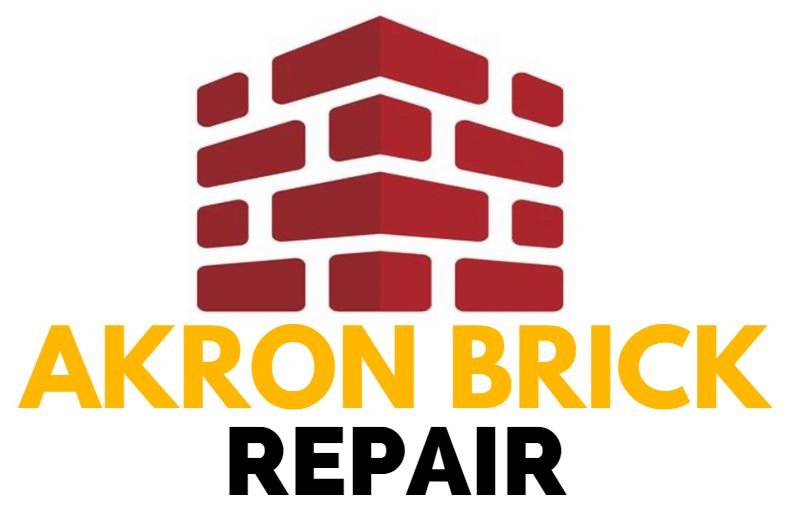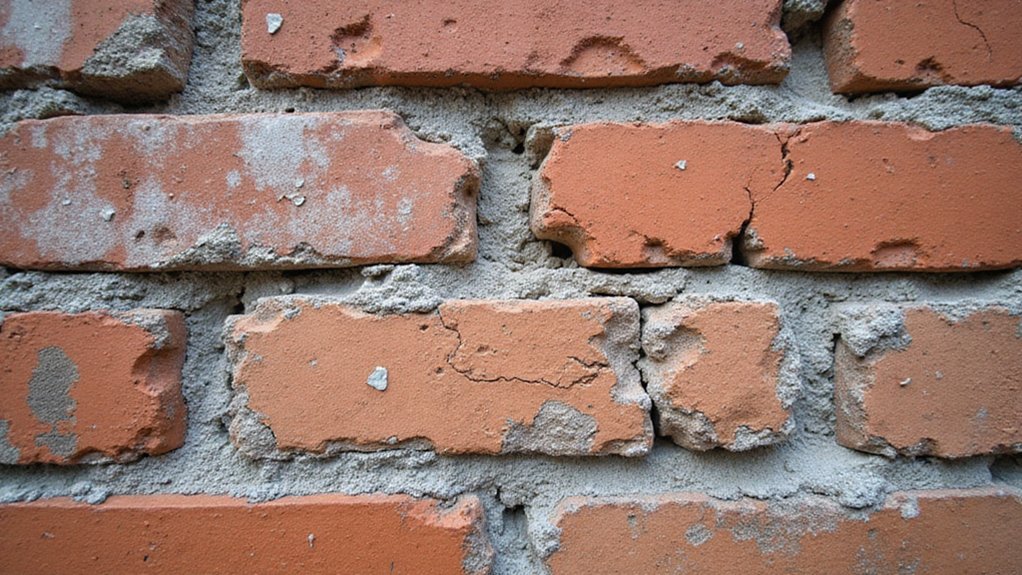Your home’s brickwork tells a story of structural health, and sometimes that story isn’t pretty. Cracks, crumbling mortar, and mysterious white residue aren’t just cosmetic issues—they’re warning signs of potential serious damage. If you’ve noticed any of these red flags, your brick walls might be crying out for professional attention. Want to know what these signs mean and why they matter? Keep reading to protect your home’s foundation and integrity.
Crumbling or Flaking Mortar Joints
When your brickwork starts showing signs of deteriorating mortar joints, it’s crucial to understand the potential risks and necessary repairs.
Missing grout lines can signal serious structural problems that’ll compromise your home’s foundation. You might notice sand-like debris around your bricks or see gaps where mortar used to be. These compromised structural integrity indicators mean water can easily penetrate your walls, causing further damage.
Don’t overlook these warning signs—they can lead to more costly repairs if left unchecked. Professional assessment and timely intervention can save you significant time and money in the long run. Expert masonry contractors recommend evaluating the condition of your building’s mortar joints to prevent extensive structural damage.
Visible Cracks in Brick Walls
Because brick walls develop cracks over time, understanding their significance can help homeowners address potential structural issues before they escalate. Visible cracks in your wall might indicate serious problems, especially when they’re accompanied by discolored bricks or an uneven surface. Horizontal cracks often suggest foundation settlement, while vertical or diagonal cracks could signal structural stress. Don’t ignore these warning signs—they’re your wall’s way of communicating potential damage. Small hairline cracks might seem harmless, but they can widen, compromising your home’s integrity and potentially leading to more expensive repairs. Freeze/thaw cycles can accelerate mortar deterioration and contribute to brick damage, increasing the urgency of professional inspection and repair.
White Powdery Residue (Efflorescence)
If you’re spotting a chalky, white substance creeping across your brick surfaces, you might be dealing with efflorescence. These salt deposits often appear after moisture seeps into your brickwork and then evaporates, leaving behind a telltale white residue.
Freeze thaw cycles can exacerbate this problem, causing more significant damage to your walls over time. While it might look harmless, efflorescence signals potential moisture issues that could compromise your brick’s structural integrity. Don’t ignore these white patches – they’re your brickwork’s way of communicating underlying problems that need attention.
Bulging or Bowing Brick Walls
Salt deposits aren’t the only warning sign your brickwork might send. If you notice your brick walls bulging or bowing outward, it’s time to pay attention.
Uneven brick patterns and discolored brickwork often indicate serious structural problems that can’t be ignored. These changes suggest underlying issues like water damage, foundation settlement, or compromised mortar. Left unchecked, bulging walls can lead to significant structural damage and costly repairs.
You’ll want to consult a professional who can assess the extent of the problem and recommend the best course of action to protect your home’s integrity.
Water Stains and Moisture Penetration
Water stains on your brickwork can be more than just an aesthetic eyesore—they’re often a critical warning sign of underlying moisture problems. These discolored patches indicate that water is penetrating your brick walls, potentially causing serious structural damage.
You’ll want to investigate improper drainage or damaged flashing that might be allowing moisture to seep into your walls. Dark streaks, white mineral deposits, or soft, crumbling mortar are telltale signs that water is compromising your home’s integrity. Don’t ignore these warning signals—they could lead to costly repairs if left unchecked.
Loose or Shifting Bricks
Because loose or shifting bricks can signal serious structural problems, homeowners should pay close attention to any signs of brick movement. When you notice misaligned mortar lines or protruding individual bricks, it’s time to investigate. These changes might indicate underlying foundation issues or water damage that could compromise your home’s integrity.
Don’t ignore small movements, as they can quickly escalate into more significant structural concerns. Shifting bricks aren’t just an aesthetic problem—they can lead to expensive repairs if left unchecked. Addressing these warning signs early can save you time, money, and stress in the long run.
Chimney Damage and Deterioration
As shifting bricks can reveal deeper structural issues, your chimney’s condition deserves equally meticulous examination. Cracked mortar, leaning structures, and visible fractures might signal serious damage threatening your home’s structural integrity.
You’ll want to watch for signs like fallen bricks around the base, unusual tilting, or roof leaks near the chimney connection. These indicators often suggest underlying problems that could jeopardize your home’s safety.
Professional inspection becomes essential when you notice spreading cracks, deteriorating masonry, or chunks of brick breaking away. Addressing these warning signs early can prevent costly repairs and potential structural collapse.
Foundation Settlement Signs
When foundation settlement begins, homeowners might notice telltale signs that shouldn’t be ignored. Uneven ground can indicate serious structural shifts, potentially caused by soil erosion and unstable terrain.
You’ll want to watch for diagonal cracks in walls, sloping floors, and doors that stick or won’t close properly. These symptoms suggest your home’s foundation might be moving, which can compromise its structural integrity.
If you’re seeing these warning signs, it’s pivotal to have a professional inspect your property. Early detection can prevent more extensive and expensive damage, helping you maintain your home’s safety and value.
Vegetation Growth on Brick Surfaces
If moss, algae, or vines start creeping across your brickwork, you’re witnessing more than just a cosmetic issue. These organic invaders can signal serious moisture problems and potential structural damage.
Discolored bricks with organic debris accumulation aren’t just unsightly; they’re warning signs of underlying moisture retention and potential decay. Left unchecked, vegetation growth can penetrate mortar joints, causing them to weaken and crumble.
You’ll want to address these green intruders quickly to prevent extensive damage and costly repairs. Professional cleaning and assessment can help you protect your home’s exterior and maintain its structural integrity.
Brick Spalling and Surface Damage
The brick wall’s battle scars—known as spalling—are more than just surface-level cosmetic blemishes. When moisture infiltrates your bricks, it causes pieces to crack, chip, and break away, revealing underlying structural vulnerabilities.
You’ll notice discoloration patterns, typically with flaking, scaling, or crumbling surfaces that signal potential damage. Spalling repair methods vary depending on the extent of deterioration, but early intervention can prevent costly reconstructions.
Professional masons can assess the damage, recommend appropriate treatments, and restore your brickwork’s integrity. Don’t ignore these warning signs—they’re your wall’s way of asking for help.
Frequently Asked Questions
How Much Does Professional Brick Repair Typically Cost?
You’ll typically spend $500-$3,000 for professional brick repair, with average brick repair costs ranging from $10-$50 per square foot, depending on damage extent and your specific repair needs.
Can I Repair Brick Damage Myself or Hire Professionals?
You’ll need proper technique and safety considerations to tackle brick repair. For complex issues, professionals offer knowledge, but DIY is possible with research, right tools, and careful approach.
What Causes Most Brick and Mortar Deterioration in Homes?
You’ll find freeze thaw cycles and moisture penetration are your biggest brick enemies. These natural forces break down mortar, causing cracks that invite further structural damage to your home’s beloved masonry.
How Often Should Homeowners Inspect Their Brick Structures?
You’ll want to perform seasonal inspections twice yearly—spring and fall—and follow regular maintenance schedules to catch potential brick damage early and protect your home’s structural integrity.
Will Homeowners Insurance Cover Brick Repair and Restoration?
Your homeowners policy might cover brick damage if it’s sudden and accidental. You’ll need to file a claim and have an adjuster assess the damage before restoration begins.

